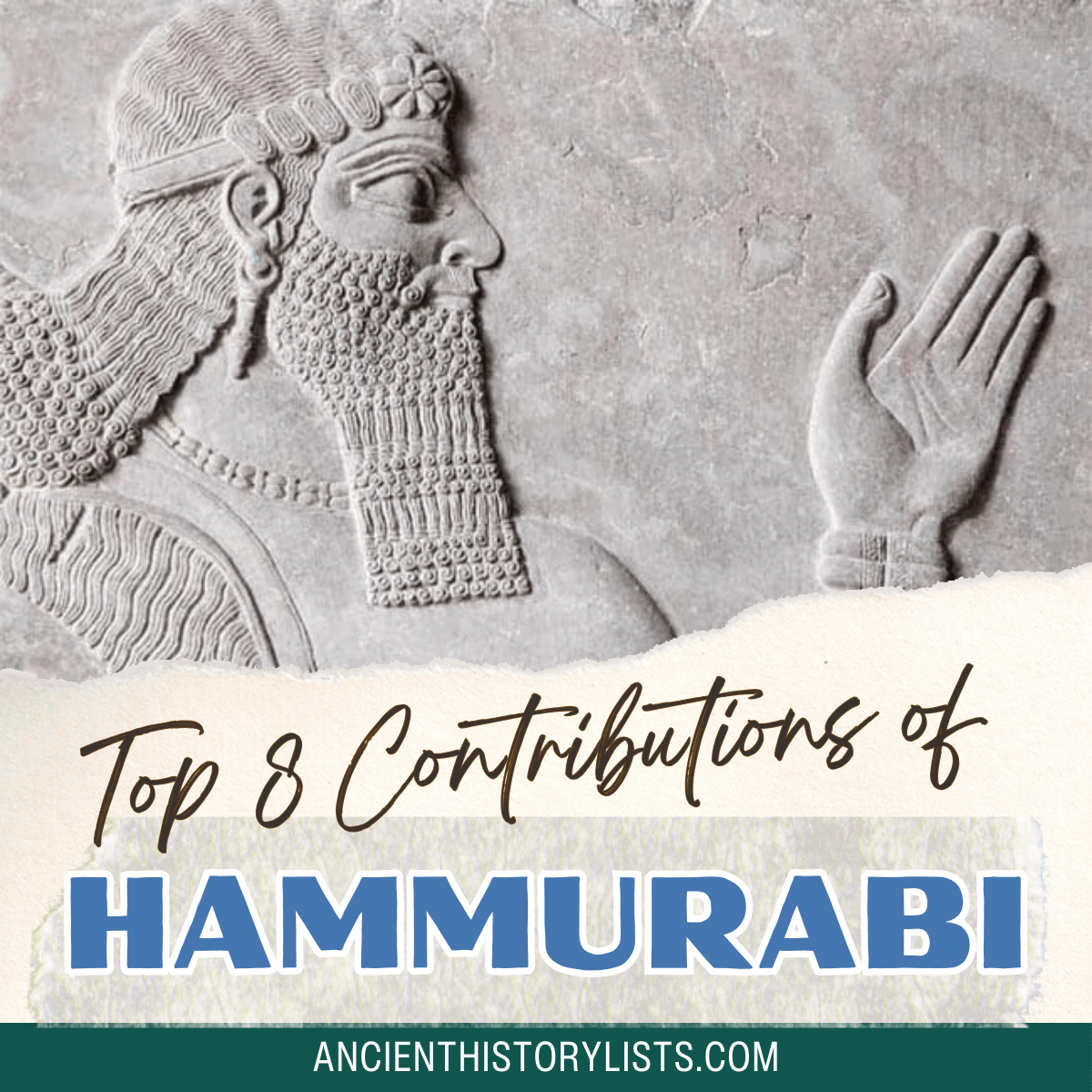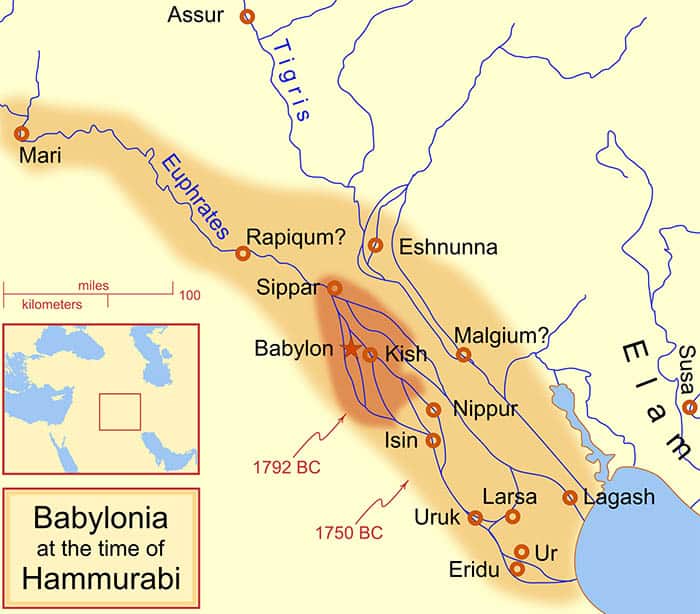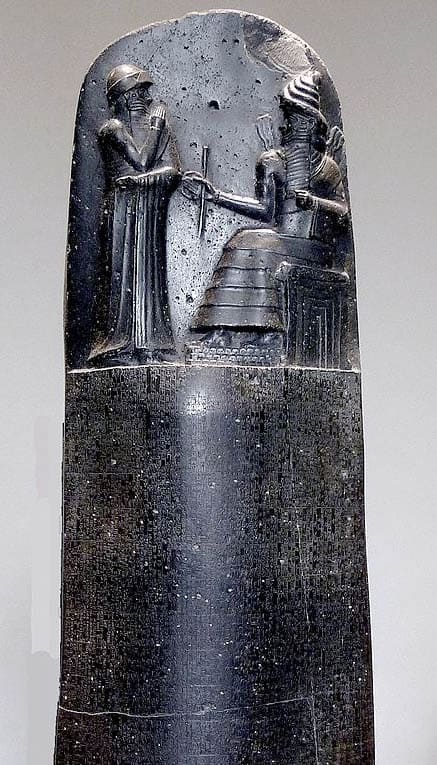Hammurabi, also known as Khammurabi, was the greatest emperor of Babylon and one of the greatest rulers in the world.
He was the sixth emperor of the Amorites, and he inherited the throne from his father, Sin-Muballit.
He was born in the city of Babylon in 1810 BC, now present-day Iraq. His contributions to the development of Babylon were outstanding.
Hammurabi’s greatest achievement was to bring together his kingdom’s previously unstable states which had no system of government or law.
He introduced a certain set of laws known as the Code of Hammurabi which was applied throughout Mesopotamian society. This was a simple but effective change. Hammurabi combined all these states and cities into a powerful empire in which every citizen lived by the same rules.

Here are the top eight contributions of Hammurabi which made him one of the greatest rulers in the world:
1. The Great Empire of Babylon
Hammurabi expanded his empire from the river valleys of the Tigris and Euphrates and ruled the entire empire with strength and determination. Hammurabi was honored in the second millennium BC above all other kings and was declared to be a living god, giving rise to his common name Hammurabi-ili, meaning “Hammurabi is my god.”
Hammurabi is remembered for three outstanding contributions which endured long after his death: He brought victory in war, he developed justice, and he established peace throughout the empire.
2. Mesopotamia Conquered

By MapMaster – Own work, CC BY-SA 4.0, Link
With his innate ability and vision, Hammurabi began to expand his empire. He did this by making allegiances with adjacent states or occupying them by force. His first conquest was of Elam, which he defeated by forming an alliance with the city-state of Larsa. After conquering Elam, he broke the alliance with Larsa to invade other city-states such as Uruk and Isin, which belonged to Larsa.
In order to conquer Uruk, he allied with Nippur and Lagash, then he broke the alliance with them as well, confusing everyone in the process. Finally, he took Larsa and achieved his original goal. After conquering the southern regions of Mesopotamia, he then turned his attention to the northern and western regions. In 1761 BC, he attacked and destroyed the whole of Mavi instead of simply occupying it. After that, he took the region of Ayira and defeated the other remaining states. In this way, Hammurabi was able to conquer the whole of Mesopotamia by 1750 BC.
3. Code of Hammurabi

While Hammurabi spent a lot of time building his empire, he also turned his attention to the Mesopotamian constitution, creating a judicial system like never before. His set of rules, known as the Code of Hammurabi, were the most comprehensive set of laws in the ancient world. These laws were written on 12 stones and displayed in public so that everyone could see them.
The code contained 282 rules, written in the format: “If … then …” These principles were classified into domestic, social and commercial laws and included everything from property, marriage, and family relations to technical procedures, and crime and punishment.
There were laws for the protection of women, children, slaves, and property, and provision was made for those affected by famine, flood, and drought. Hammurabi introduced the idea of crime and punishment. Punishments were not fixed, and they varied according to the severity of the crime. Some details of the code are as follows:
- There were some cases where the punishment was a thousand times more severe than the crime.
- The terms and conditions were changed according to gender and class.
- The law ensured a minimum wage for workers.
- If someone provided a false testimony, then he was sentenced to death.
The code survived long after Hammurabi’s death.
4. Internal Developments and Architecture
After creating his huge empire from a relatively small state, Hammurabi turned his attention to the internal development of the kingdom. He developed a large infrastructure including public buildings and temples and was one of the greatest administrators, supervising many of the works himself.
The city of Babylon benefited from roads, gardens, and lakes which were often built purely for aesthetic reasons, and in this way, Hammurabi ensured that Babylon would be remembered long after his death.
5. Protector of the Realm
Hammurabi was the emperor for several decades, and during this time, he not only built and developed the empire, but he also protected it by allying himself with or attacking adjacent states.
To repel enemy attack, Hammurabi constructed canals within the city of Babylon as they provided another line of defense. He also raised the city walls to protect it from attack. In this way, he was able to maintain peace in the city during his reign.
6. Urbanization
Most of the development of the city of Babylon was done during Hammurabi’s reign. Babylon was the first city to have 200,000 people living together at the same time, and while other emperors helped to build this population, Hammurabi’s contribution was undoubtedly the greatest of them all. With his extensive building work, he gave Babylon a new look which attracted many people to settle there and enjoy a standard of living they had not previously known.
Much of what we know about the daily life of Babylonian citizens comes from 55 letters probably written by Hammurabi himself. In them, he talks about the challenges he faced in ruling the empire such as how to deal with floods and what precautions needed to be taken with regards to the Babylonian calendar.
7. Agricultural Development
Hammurabi knew that an empire needed a strong agricultural base on which to develop. Babylon was situated in the Tigris and Euphrates river valley, and Hammurabi harnessed the water from these rivers and constructed canals to supply water to all parts of the kingdom, thus enabling farmers to develop better methods of agriculture. Babylonians learned how to successfully cultivate fruit, vegetables, and crops in the fertile soils.
8. Classification of Society
Hammurabi thought a proper division of society was important to establish peace within the empire. With this in mind, he divided Babylonian society into three parts:
- Patricians who were free men and women.
- Plebeians who were common people in the city.
- Slaves who were the lowest class of people.
There were different laws for these different classes. As the patricians were the highest class, they were always protected by the law and enjoyed greater power and freedom, whereas the slaves only received compensation in relation to money matters.
Conclusion
Hammurabi was a ruthless king known for his ambition and vision, but it seems that he did balance his mistakes with developments aimed at improving the lives of his citizens. In this way, while he can neither be classified as a good nor a bad ruler, he was undoubtedly one of the greatest.
During his reign, Babylon was known as “one of the most holy cities in Mesopotamia,” and within the first few years of Hammurabi’s reign, he had established peace throughout the realm. After his death in 1750 BC, the empire was passed to his son Samsu-iluna, and it was during Samsu-iluna’s rule that it began its slow decline.